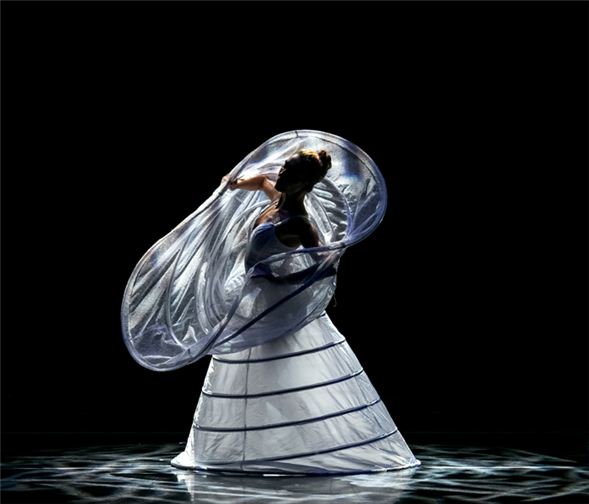Moses Pendelton and his vision for Momix
--
Momix founder and choreographer Moses Pendleton fits the bill of a mad dance scientist: His creations are otherworldly – etched with ethereal visuals that incorporate inventive technology – and since he asks dancers to slip between classical technique and acrobatic pyrotechnics, he seems disinterested in the rules as we understand them.
However, there's always something solid within these experiments. Whenever it seems a piece might float away, arching shapes and organic phrasing anchor Pendelton's work.
Still, he describes this tincture in the language of lab coats and test tubes. "For 35 years, I've thought of Momix in alchemical metaphors," he says. "If you can take disparate elements, spin them in a retort and make them move quickly, they change their atomic number, their form. Momix works that way, and alchemy is a tool in my mind that energizes me to figure out various onstage and movement problems I face."
From July 6 through August 1, audiences can catch Pendleton's sorcery at the Joyce, where Momix's 35th anniversary presentation is aptly titled Alchemia.
In this piece, Pendleton uses his "moving sculptures" and wide choreographic sweeps to represent fire, air, earth, and water – and how they blend and change each other.
To wit: The dancers are often paired with large props, such as enormous, bamboo-like sticks and hooped, translucent cocoons that can be shaped around the body. These tangible elements interact with a variety of video backgrounds to offer a whirlwind of visceral experiences. The audience doesn’t only see flames digitally, for instance, but also watches the energy of the fire in whipping legs and billowing red skirts. Eventually, the piece turns to a section about gold (the desired endpoint for so many alchemists), with shimmering, glistening dancers serving as an expression of the precious metal.
{Image1}
Audiences familiar with Momix's past work will continue to see an evolution toward flowing phrases, which balance the impressive technical feats the company is so famous for. Jennifer Chicheportiche, dance captain and assistant choreographer, says, "Now, he's working with details and trying to find a story that's connected to the title, more so than ever before."
But Momix's crux remains organic creation, and Alchemia was made firmly in this tradition. While spending time in the countryside, Pendleton recalls, "I was thinking about how to organize massive amounts of landscape and gardening, and just as I was about to mow, a certain section of my garden filled with white daffodils that I saw in moonlight. I let it go fallow, and marvelous, wild flowers grew. It's fascinating to see how nature runs its course. My choreographic nature is not dissimilar: It's a naturalist approach to creativity, and that's the theme of this show especially."
In the studio, this manifests in a playful environment where the dancers have a tremendous amount of input into the product that ends up onstage. Chicheportiche, who was one of a small group of dancers/collaborators to help create Alchemia, explains "Moses has an idea, but the dancers are the ones expressing his ideas. He doesn't get up and show us what to do. He guides. He will come in with a prop or a piece of music. He tells us about his vision, and then we use our personality and movement to develop phrases and shapes. This allows you to take ownership of whatever you do. The studio becomes like a playground. We don't know what will happen. We find it together."
To rein in the free-wheeling process, Pendleton watches tape of the day's work at night, choosing sections to build upon or tweak during the following session.
The result can be uncertain, though, even in the final stages: "One week before Alchemia was shown the first time, we didn't truly know what it would be," says Chicheportiche. "When we had the theatre for the week, Moses was working with the lighting and projections, which is a big part of his vision, but one we don't see in the studio. When we all watched the tape of the run, we realized, 'Oh, there's a show.'"
Chicheportiche says this approach requires a large amount of trust on both ends, and Pendleton agrees, noting that he searches for artists who don't merely handle the collaborative messiness, but thrive within it. "I always demand more from dancers: a sense of musicality, but also someone who can create ideas around her own body. My dancers must be catalysts."
While Chicheportiche understands this method now, it took time to master it. "Though I loved and wanted to be in Momix, there's no school to train you to be a part of it. I wasn't born to do it," she says, with a laugh. "They see if you can adapt when you're hired. It takes time to get to that point. Now, I'm a Momix dancer, and I know how to work with props and Moses, even when he's impatient. He wants us to be able to do the work quickly. But because it's different, it's challenging! Now that I've collaborated with him for a while, I feel confident to speak up, share my ideas and suggestions, and he listens."
For his part, Pendelton says this push-pull keeps his work fresh, and one of his top priorities is supporting the artistic tornadoes that result in a unique piece of art. "You evolve by maintaining that alchemical energy," he says. "Einstein would agree. My job, as director, is to make sure we don't lose power, that we don't lose vitality. I do so by maintaining a reverence for the mysterious."
--
A writer and dancer, Lauren Kay regularly covers dance for TDF Stages
Photos by Sharen Bradford. Top photo: An Alechemia dancer works with a cocoon-like prop.
